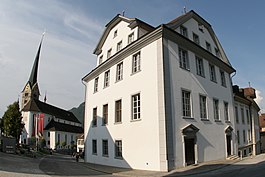Stans
| Stans | ||
|---|---|---|
 |
||
|
||
| Coordinates: 46°57′N 8°21′E / 46.950°N 8.350°ECoordinates: 46°57′N 8°21′E / 46.950°N 8.350°E | ||
| Country | Switzerland | |
| Canton | Nidwalden | |
| District | n.a. | |
| Government | ||
| • Mayor |
Gemeindepräsidentin Beatrice Richard-Ruf FDP/PRD |
|
| Area | ||
| • Total | 11.09 km2 (4.28 sq mi) | |
| Elevation | 452 m (1,483 ft) | |
| Population (Dec 2015) | ||
| • Total | 8,277 | |
| • Density | 750/km2 (1,900/sq mi) | |
| Postal code | 6370 | |
| SFOS number | 1509 | |
| Surrounded by | Buochs, Dallenwil, Ennetbürgen, Ennetmoos, Oberdorf, Stansstad | |
| Website |
www SFSO statistics |
|
Stans (German pronunciation: [ʃtans]) is the capital of the canton of Nidwalden (Nidwald) in Switzerland.
The official language of Stans is (the Swiss variety of Standard) German, but the main spoken language is the local variant of the Alemannic Swiss German dialect.
Stans is one of the oldest settlements in the entire Nidwalden valley. The first traces of human settlement date to the 2nd Century BC. During the Roman era there is little evidence of a settlement except for some Gallo-Roman Ustrinum or funeral pyres and the Latin root (stagnum meaning a pool or sump) of the name Stans.
During the 7th or 8th Century the Alamanni settled in the region. The christian Alamanni built the first church in Stans around 750 AD. This pre-Carolingian church served as the parish church for the entire Engelberg Valley. The church was expanded numerous times until it was finally replaced in 1647 by the new church of St. Peter and Paul.
Stans was first mentioned in 1124. By 1291, when Unterwalden joined Uri and Schwyz in what became the Swiss Confederation, Stans was already the capital of the section known as Unterwalden nid dem Kernwald which would become the half canton of Nidwalden.
...
Wikipedia



